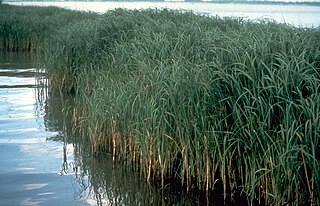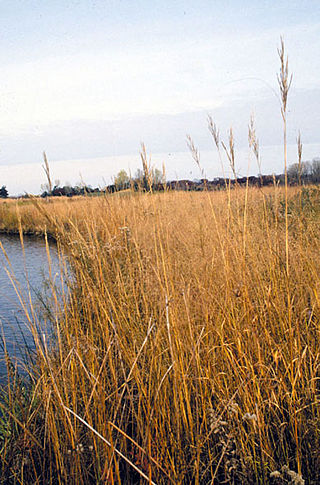
A salt marsh, saltmarsh or salting, also known as a coastal salt marsh or a tidal marsh, is a coastal ecosystem in the upper coastal intertidal zone between land and open saltwater or brackish water that is regularly flooded by the tides. It is dominated by dense stands of salt-tolerant plants such as herbs, grasses, or low shrubs. These plants are terrestrial in origin and are essential to the stability of the salt marsh in trapping and binding sediments. Salt marshes play a large role in the aquatic food web and the delivery of nutrients to coastal waters. They also support terrestrial animals and provide coastal protection.

The Tantramar Marshes, also known as the Tintamarre National Wildlife Area, is a tidal saltmarsh around the Bay of Fundy on the Isthmus of Chignecto. The area borders between Route 940, Route 16 and Route 2 near Sackville, New Brunswick. The government of Canada proposed the boundaries of the Tantramar Marshes in 1966 and was declared a National Wildlife Area in 1978.

Spartina is a genus of plants in the grass family, frequently found in coastal salt marshes. Species in this genus are commonly known as cordgrass or cord-grass, and are native to the coasts of the Atlantic Ocean in western and southern Europe, north-western and southern Africa, the Americas and the islands of the southern Atlantic Ocean; one or two species also occur on the western coast of North America and in freshwater habitats inland in the Americas. The highest species diversity is on the east coasts of North and South America, particularly Florida. They form large, often dense colonies, particularly on coastal salt marshes, and grow quickly. The species vary in size from 0.3–2 m tall. Many of the species will produce hybrids if they come into contact.

Sporobolus alterniflorus, or synonymously known as Spartina alterniflora, the smooth cordgrass, saltmarsh cordgrass, or salt-water cordgrass, is a perennial deciduous grass which is found in intertidal wetlands, especially estuarine salt marshes. It has been reclassified as Sporobolus alterniflorus after a taxonomic revision in 2014, but it is still common to see Spartina alterniflora and in 2019 an interdisciplinary team of experts coauthored a report published in the journal Ecology supporting Spartina as a genus. It grows 1–1.5 m tall and has smooth, hollow stems that bear leaves up to 20–60 cm long and 1.5 cm wide at their base, which are sharply tapered and bend down at their tips. Like its relative saltmeadow cordgrass S. patens, it produces flowers and seeds on only one side of the stalk. The flowers are a yellowish-green, turning brown by the winter. It has rhizoidal roots, which, when broken off, can result in vegetative asexual growth. The roots are an important food resource for snow geese. It can grow in low marsh as well as high marsh, but it is usually restricted to low marsh because it is outcompeted by salt meadow cordgrass in the high marsh. It grows in a wide range of salinities, from about 5 psu to marine, and has been described as the "single most important marsh plant species in the estuary" of Chesapeake Bay. It is described as intolerant of shade.

Sporobolus anglicus is a species of cordgrass that originated in southern England in about 1870 and is a neonative species in Britain. It was reclassified as Sporobolus anglicus after a taxonomic revision in 2014, but Spartina anglica is still in common usage. It is an allotetraploid species derived from the hybrid Sporobolus × townsendii, which arose when the European native cordgrass Sporobolus maritimus hybridised with the introduced American Sporobolus alterniflorus.

Sporobolus maritimus, or synonymously as Spartina maritima, the small cordgrass, is a species of cordgrass native to the coasts of western and southern Europe and western Africa, from the Netherlands west across southern England to southern Ireland, and south along the Atlantic coast to Morocco and also on the Mediterranean Sea coasts. There is also a disjunct population on the Atlantic coasts of Namibia and South Africa.

Brackish marshes develop from salt marshes where a significant freshwater influx dilutes the seawater to brackish levels of salinity. This commonly happens upstream from salt marshes by estuaries of coastal rivers or near the mouths of coastal rivers with heavy freshwater discharges in the conditions of low tidal ranges.

Littoraria irrorata, also known by the common name the marsh periwinkle, is a species of sea snail, a marine gastropod mollusk in the family Littorinidae. The specific epithet irrorata means 'moistened' or 'dewy.'

Sporobolus michauxianus is a species of cordgrass known as prairie cordgrass, freshwater cordgrass, tall marshgrass, and sloughgrass. It is native to much of North America, including central and eastern Canada and most of the contiguous United States except for the southwestern and southeastern regions. Its distribution extends into Mexico. It is also present on other continents as an introduced species.
Puccinellia nutkaensis is a species of grass known by the common names Nootka alkaligrass and Alaska alkali grass. It is native to North America from Alaska across northern Canada to Greenland and Nova Scotia, and down to Washington to Oregon to the Central Coast of California.

Salt pannes and pools are water retaining depressions located within salt and brackish marshes. Pools tend to retain water during the summer months between high tides, whereas pannes generally do not. Salt pannes generally start when a mat of organic debris is deposited upon existing vegetation, killing it. This creates a slight depression in the surrounding vegetation which retains water for varying periods of time. Upon successive cycles of inundation and evaporation the panne develops an increased salinity greater than that of the larger body of water. This increased salinity dictates the type of flora and fauna able to grow within the panne. Salt pools are also secondary formations, though the exact mechanism(s) of formation are not well understood; some have predicted they will increase in size and abundance in the future due to rising sea levels.

Sporobolus montevidensis is a species of grass known by the common name denseflower cordgrass. Although reclassified after a taxonomic revision in 2014, it may still be referred to as Spartina densiflora by some users. It is native to the coastline of southern South America, where it is a resident of salt marshes. It is also known on the west coast of the North America and parts of the Mediterranean coast as an introduced species and in some areas a noxious weed. In California it is a troublesome invasive species of marshes in San Francisco Bay and in Humboldt Bay, where it was introduced during the 19th century from Chile in ballast.

Sporobolus foliosus is a species of grass known by the common name California cordgrass. It was reclassified from Spartina foliosa after a taxonomic revision in 2014. It is native to the salt marshes and mudflats of coastal California and Baja California, especially San Francisco Bay. It is a perennial grass growing from short rhizomes. It produces single stems or clumps of thick, fleshy stems that grow up to 1.5 meters tall. They are green or purple-tinged. The long, narrow leaves are flat or rolled inward. The inflorescence is a narrow, dense, spike-like stick of branches appressed together, the unit reaching up to 25 centimeters long. The lower spikelets are sometimes enclosed in the basal sheaths of upper leaves.

Sporobolus hookerianus is a species of grass known by the common name alkali cordgrass.

Sporobolus pumilus, the saltmeadow cordgrass, also known as salt hay, is a species of cordgrass native to the Atlantic coast of the Americas, from Newfoundland south along the eastern United States to the Caribbean and north-eastern Mexico. It was reclassified after a taxonomic revision in 2014, but the older name, Spartina patens, may still be found in use. It can be found in marshlands in other areas of the world as an introduced species and often a harmful noxious weed or invasive species.

Juncus roemerianus is a species of flowering plant in the rush family known by the common names black rush, needlerush, and black needlerush. It is native to North America, where its main distribution lies along the coastline of the southeastern United States, including the Gulf Coast. It occurs from New Jersey to Texas, with outlying populations in Connecticut, New York, Mexico, and certain Caribbean islands.

Setaria parviflora is a species of grass known by the common names marsh bristlegrass, knotroot bristle-grass, bristly foxtail and yellow bristlegrass. It is native to North America, including Mexico and the United States from California to the East Coast, Central America and the West Indies, and South America.

Sporobolus bakeri is a species of grass known by the common names sand cordgrass and bunch cordgrass. It is native to the south-eastern United States, where it grows along the coast and in inland freshwater habitat in Florida.

Sporobolus spartinae is a species of grass known by the common names gulf cordgrass and sacahuista. It is native to the Americas, where it occurs from the Gulf Coast of the United States south to Argentina.

A Louisiana native plant nursery is a plant nursery that only grows native plants indigenous to Louisiana. Native plant nurseries primarily produce and propagate native plants with the intention to restore and replenish the diversity of native flora. In Louisiana, these nurseries are a source of plants used for wetland and coastal restoration projects. Nurseries provide a controlled environment that is ideal for plant research for ecosystem restoration. The resulting information from plant research can be used to develop better strains of specific species. Cloning these strains of plants insures the quota for a restoration project is successfully met.



















